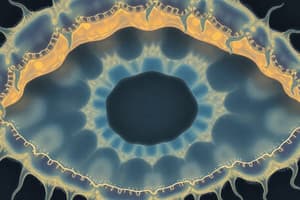Podcast
Questions and Answers
Which reproductive process involves a parent cell dividing into multiple fragments, each developing into a new individual?
Which reproductive process involves a parent cell dividing into multiple fragments, each developing into a new individual?
- Multiple fission
- Binary fission
- Fragmentation (correct)
- Budding
What is the primary mechanism by which unicellular organisms exchange gases and eliminate waste products with their environment?
What is the primary mechanism by which unicellular organisms exchange gases and eliminate waste products with their environment?
- Endocytosis
- Diffusion (correct)
- Active transport
- Osmosis
Which cellular structure is notably absent in prokaryotic unicellular organisms?
Which cellular structure is notably absent in prokaryotic unicellular organisms?
- Membrane-bound organelles (correct)
- Cell membrane
- Cytoplasm
- Ribosomes
Unlike prokaryotic DNA, eukaryotic DNA is typically associated with which type of protein?
Unlike prokaryotic DNA, eukaryotic DNA is typically associated with which type of protein?
What is the primary function of cilia in Paramecium, beyond locomotion?
What is the primary function of cilia in Paramecium, beyond locomotion?
Euglena exhibits photoautotrophic nutrition due to the presence of which organelle?
Euglena exhibits photoautotrophic nutrition due to the presence of which organelle?
Valonia ventricosa, one of the largest unicellular organisms, is commonly known by what descriptive name?
Valonia ventricosa, one of the largest unicellular organisms, is commonly known by what descriptive name?
What distinguishes a unicellular organism from a multicellular organism?
What distinguishes a unicellular organism from a multicellular organism?
What is the primary function of the cell membrane in a unicellular organism?
What is the primary function of the cell membrane in a unicellular organism?
Which of the following is NOT a characteristic of unicellular organisms?
Which of the following is NOT a characteristic of unicellular organisms?
What does the term 'uni-' in 'unicellular' signify?
What does the term 'uni-' in 'unicellular' signify?
Which of the following components is NOT typically found freely floating in the cytoplasm of a unicellular organism?
Which of the following components is NOT typically found freely floating in the cytoplasm of a unicellular organism?
What is the primary function of ribosomes in unicellular organisms?
What is the primary function of ribosomes in unicellular organisms?
Which of the following is an example of a unicellular organism that is large enough to be visible without a microscope?
Which of the following is an example of a unicellular organism that is large enough to be visible without a microscope?
Which of the following are typically unicellular?
Which of the following are typically unicellular?
Flashcards
Binary Fission
Binary Fission
A type of asexual reproduction where a single cell divides into two identical daughter cells.
Multiple Fission
Multiple Fission
An asexual reproduction method where a parent cell divides to create multiple daughter cells simultaneously.
Eukaryotes
Eukaryotes
Unicellular or multicellular organisms with a true nucleus and membrane-bound organelles.
Prokaryotes
Prokaryotes
Signup and view all the flashcards
Paramecium
Paramecium
Signup and view all the flashcards
Euglena
Euglena
Signup and view all the flashcards
Diffusion
Diffusion
Signup and view all the flashcards
Unicellular Organism
Unicellular Organism
Signup and view all the flashcards
Cell
Cell
Signup and view all the flashcards
Life Activities
Life Activities
Signup and view all the flashcards
Asexual Reproduction
Asexual Reproduction
Signup and view all the flashcards
Cell Membrane
Cell Membrane
Signup and view all the flashcards
Cytoplasm
Cytoplasm
Signup and view all the flashcards
Examples of Unicellular Organisms
Examples of Unicellular Organisms
Signup and view all the flashcards
Multicellular Organisms
Multicellular Organisms
Signup and view all the flashcards
Study Notes
Unicellular Organisms
- Organisms are classified as unicellular or multicellular based on the number of cells they contain.
- A unicellular organism consists of a single cell capable of performing all life functions independently.
- Unicellular organisms include protists (e.g., Amoeba, Paramecium, Euglena), bacteria, and some fungi (e.g., yeast).
- Most unicellular organisms are microscopic, but some, like Valonia ventricosa, are visible to the naked eye.
Unicellular Organism Structure
- The cell of a unicellular organism has a cell membrane (plasma membrane) that encloses the cytoplasm (protoplasm).
- The cell membrane is semi-permeable, controlling the passage of substances to maintain a stable internal environment (homeostasis).
- The cytoplasm contains essential macromolecules (proteins, lipids, carbohydrates, nucleic acids) and cell organelles (primarily ribosomes).
Unicellular Organism Characteristics
- A single cell carries out all life processes (e.g., homeostasis, metabolism, reproduction).
- Reproduction is primarily asexual, involving a single parent cell. Common methods are binary fission, multiple fission, fragmentation, and budding.
- Unicellular organisms inhabit diverse environments, including extreme conditions (e.g., hot springs, arctic environments).
- Some have structures for movement (e.g., cilia in Paramecium, flagella in Euglena).
- Diffusion facilitates gas exchange (O2, CO2) and waste removal.
Types of Unicellular Organisms
- Prokaryotes: Lack a true nucleus and membrane-bound organelles.
- DNA is naked (not associated with histones).
- Small size (0.1-5.0 micrometers) facilitates diffusion.
- Examples include bacteria.
- Eukaryotes: Have a nucleus and membrane-bound organelles.
- DNA is associated with histone proteins.
- Larger size (5-100 micrometers).
- Examples include Paramecium, Euglena, and Valonia ventricosa.
Examples of Unicellular Organisms
- Paramecium: Found in freshwater. Uses cilia for movement, feeding, and touch sensation. Contains contractile vacuoles for osmoregulation and food vacuoles for digestion.
- Euglena: Found in freshwater. Moves with a flagellum. Can perform photosynthesis (photoautotrophic) or absorb organic molecules (saprotrophic).
- Valonia ventricosa: Large, spherical or oval unicellular alga found in tropical/subtropical habitats.
- Amoeba: Found in freshwater. Moves using pseudopodia. Contains a contractile vacuole, food vacuoles, and other organelles.
Studying That Suits You
Use AI to generate personalized quizzes and flashcards to suit your learning preferences.




